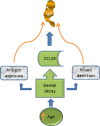Salivary Immunoglobulin Gene Expression in Patients with Caries
- PMID: 28507635
- PMCID: PMC5420781
- DOI: 10.3889/oamjms.2017.028
Salivary Immunoglobulin Gene Expression in Patients with Caries
Abstract
Background: Immunoglobulins mediate the host's humoral immune response are expressed in saliva.
Aim: To quantify the FcαR, FcγRIIB, and FcαμR gene expression in the saliva of Mexican patients with caries in mixed and permanent dentition.
Subjects and methods: This was a comparative cross-sectional study. mRNA was isolated from 200 μL of saliva following the RNA III Tissue Fresh-frozen protocol of the MagNA Pure LC Instrument 2.0 (Roche Diagnostics GmbH, Nederland BV) and the FcαR, FcαμR and FcγRIIB were quantified through TaqMan Assays.
Results: One hundred individuals, 50 with mixed dentition and 50 with permanent dentition, were included in the study. Statistically, it was found a significant difference (p = 0.025) in the IgG (FcγRIIB) expression between the studied groups.
Conclusion: Although we confirmed the existence of FcαR, FcγRIIB and FcαμR gene expression in saliva, only a significant difference in the expression of FcγRIIB between the mixed dentition and permanent dentition was found.
Keywords: caries; gene expression; mixed dentition; permanent dentition; saliva.
Figures
References
-
- Henostroza HG. Caries dental, principios y procedimientos para el diagnó. stico Ripano, Lima, Perú. 2007 PMCid:PMC1933042.
-
- Lujan HE, Sexto M. Factores de riesgo de caries dental en ni-os. MediSur. 2007;5:16–21.
-
- Irigoyén-Camacho ME. [Dental caries in schoolchildren of the Federal District] Salud Publica Mex. 1997;39:133–136. https://doi.org/10.1590/S0036-36341997000200007 . PMid:9254437. - PubMed
-
- Casanova-Rosado AJ, Medina-Solís CE, Casanova-Rosado JF, Vallejos-Sánchez AA, Maupomé G, Avila-Burgos L. Dental caries and associated factors in Mexican schoolchildren aged 6-13 years. Acta Odontol Scand. 2005;63:245–251. https://doi.org/10.1080/00016350510019865 . PMid:16040448. - PubMed
-
- Segovia-Villanueva A, Estrella-Rodríguez R, Medina-Solís CE, Maupome G. Dental caries experience and factors among preschoolers in southeastern Mexico: a brief communication. J Public Health Dent. 2006;66:88–91. https://doi.org/10.1111/j.1752-7325.2006.tb02561.x . PMid:16711626. - PubMed
Publication types
LinkOut - more resources
Full Text Sources
Other Literature Sources


